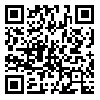Sat, Apr 27, 2024
Volume 32, Issue 1 (1-2022)
JHNM 2022, 32(1): 40-48 |
Back to browse issues page
Download citation:
BibTeX | RIS | EndNote | Medlars | ProCite | Reference Manager | RefWorks
Send citation to:



BibTeX | RIS | EndNote | Medlars | ProCite | Reference Manager | RefWorks
Send citation to:
Mohammadi S, Hanani S, Amiri F, Azadi N, Kamali N. Job Burnout and Its Related Factors Among Surgical Technologists. JHNM 2022; 32 (1) :40-48
URL: http://hnmj.gums.ac.ir/article-1-1792-en.html
URL: http://hnmj.gums.ac.ir/article-1-1792-en.html
1- Surgical Technology (MSc), Department of Operating Room, Faculty of Paramedical Sciences, Ilam University of Medical Sciences, Ilam, Iran. , smohmadi91070@gmail.com
2- Nursing (MSc), Department of Operating Room, School of Paramedical Sciences, Iran University of Medical Sciences, Tehran, Iran.
3- Nursing (MSc), Department of Biostatistics, School of Health Sciences, Iran University of Medical Sciences, Tehran, Iran.
4- Biostatistics (PhD), Department of Operating Room, School of Nursing Sciences, North Khorasan University of Medical Sciences, Bojnurd, Iran.
5- Surgical Technology (MSc), Department of Operating Room, School of Nursing Sciences, North Khorasan University of Medical Sciences, Bojnurd, Iran.
2- Nursing (MSc), Department of Operating Room, School of Paramedical Sciences, Iran University of Medical Sciences, Tehran, Iran.
3- Nursing (MSc), Department of Biostatistics, School of Health Sciences, Iran University of Medical Sciences, Tehran, Iran.
4- Biostatistics (PhD), Department of Operating Room, School of Nursing Sciences, North Khorasan University of Medical Sciences, Bojnurd, Iran.
5- Surgical Technology (MSc), Department of Operating Room, School of Nursing Sciences, North Khorasan University of Medical Sciences, Bojnurd, Iran.
Abstract: (1011 Views)
Introduction: Job burnout is a long-term response to job-related emotional and interpersonal stressors. These stressors are associated with individual, interpersonal, and organizational factors.
Objective: This study aimed to determine the degree of burnout and its related factors among surgical technologists.
Materials and Methods: This analytical cross-sectional study was conducted in hospitals affiliated with the Iran University of Medical Sciences. A total of 125 surgical technologists were recruited by stratified sampling method. The study data were collected using a demographic questionnaire and Maslach Burnout Inventory (MBI) and then analyzed by the independent t-test, 1-way analysis of variance, and multiple linear regression with a simultaneous model.
Results: More than half of the participants (52%) were in the age group of fewer than 30 years. The Mean±SD scores of job burnout in terms of intensity and frequency were 47. 88±17.5 and 47. 95±17.42, respectively. The mean job burnout scores of the majority of surgical technologists in dimensions of emotional exhaustion (intensity), depersonalization (intensity and frequency), and reduced personal accomplishment (intensity and frequency) were at a low level, but it was at a moderate level in the dimension of emotional exhaustion (frequency) among more than half of them. Through a multiple regression, the identified predictors of job burnout (frequency) were education level (β=9.377, 95%CI; 1.618-17.136, P<0.05) and work experience (β=-21.091, 95%CI; -38.201- -3.980, P<0.05). Meanwhile, education level (β=8.320, 95%CI; 0.568- 16.073, P<0.05), work experience (β=-30.976, 95%CI; -54.715 - -7.236, P<0.05), and hours of night shifts per month (β=-10.660, 95%CI; -18.205- -3.115, P=0.01) predicted job burnout (intensity).
Conclusion: The job burnout of more than half of surgical technologists in the dimension of emotional exhaustion (frequency) was at a moderate level. Novice workers and operating room BScs suffered more from job burnout than those with an Associate degree and experienced workers. In this regard, healthcare and planner providers must pay attention to operating room BScs, especially novice workers.
Objective: This study aimed to determine the degree of burnout and its related factors among surgical technologists.
Materials and Methods: This analytical cross-sectional study was conducted in hospitals affiliated with the Iran University of Medical Sciences. A total of 125 surgical technologists were recruited by stratified sampling method. The study data were collected using a demographic questionnaire and Maslach Burnout Inventory (MBI) and then analyzed by the independent t-test, 1-way analysis of variance, and multiple linear regression with a simultaneous model.
Results: More than half of the participants (52%) were in the age group of fewer than 30 years. The Mean±SD scores of job burnout in terms of intensity and frequency were 47. 88±17.5 and 47. 95±17.42, respectively. The mean job burnout scores of the majority of surgical technologists in dimensions of emotional exhaustion (intensity), depersonalization (intensity and frequency), and reduced personal accomplishment (intensity and frequency) were at a low level, but it was at a moderate level in the dimension of emotional exhaustion (frequency) among more than half of them. Through a multiple regression, the identified predictors of job burnout (frequency) were education level (β=9.377, 95%CI; 1.618-17.136, P<0.05) and work experience (β=-21.091, 95%CI; -38.201- -3.980, P<0.05). Meanwhile, education level (β=8.320, 95%CI; 0.568- 16.073, P<0.05), work experience (β=-30.976, 95%CI; -54.715 - -7.236, P<0.05), and hours of night shifts per month (β=-10.660, 95%CI; -18.205- -3.115, P=0.01) predicted job burnout (intensity).
Conclusion: The job burnout of more than half of surgical technologists in the dimension of emotional exhaustion (frequency) was at a moderate level. Novice workers and operating room BScs suffered more from job burnout than those with an Associate degree and experienced workers. In this regard, healthcare and planner providers must pay attention to operating room BScs, especially novice workers.
Article Type : Research |
Subject:
General
Received: 2021/10/1 | Accepted: 2021/09/13 | Published: 2022/01/1
Received: 2021/10/1 | Accepted: 2021/09/13 | Published: 2022/01/1
Send email to the article author
| Rights and permissions | |
 | This work is licensed under a Creative Commons Attribution-NonCommercial 4.0 International License. |






